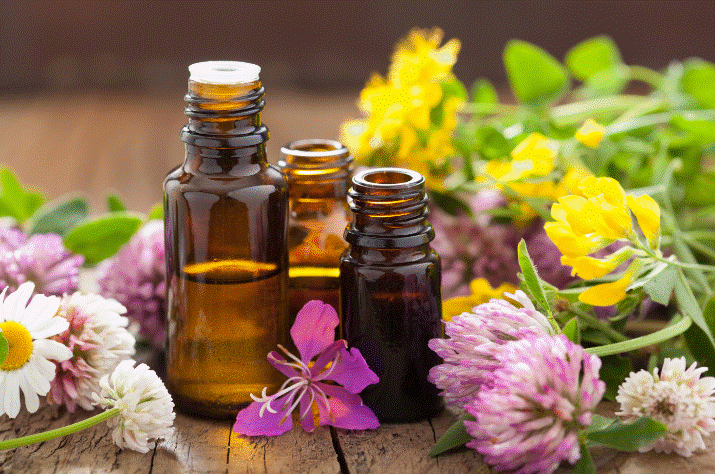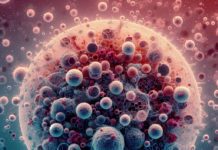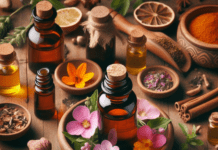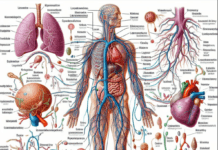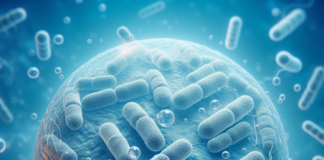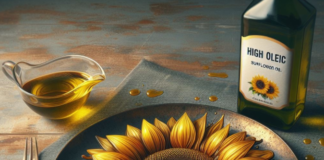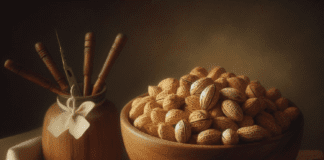Essential Oils
Around 40,000 bc, Aboriginal peoples of Australia already had a specific use for their aromatic plants – they would inhale the smoke of burning eucalyptus and tea tree to treat respiratory conditions.
They had invented fumigation, which evolved to give us present-day inhalation.
They also prepared ointments and pastes with finely ground tea tree leaves, using clay as a base to treat wounds and other skin conditions.
These remedies clearly improved living conditions for these peoples in a harsh and hostile environment.
India has such extensive aromatic plant biodiversity in this region that trade flourished. The most famous example of which, the ‘Spice Route,’ highlighted the importance of these plants on the Indian subcontinent.
It is no surprise that perfumes and other aromatic products were used in medicine and religious offerings to purify the mind and body.
At this time, Sanskrit texts listed plants and their medicinal properties concerning the chakras, which Ayurveda uses extensively in its medical practice.
The oldest text on phytotherapy appeared in China around 3500 bc; this was the precursor of our modern pharmacopeias.
It describes numerous aromatic plants used in fragrant oil preparations for massage. In China, archaeologists unearthed a utensil made of fired clay whose only possible use was the steam distillation of aromatic plants.
Around the Mediterranean, aromatic plants were widely used both in everyday life and in rituals.
In Egypt, between around 2000 and 3000 bc, the use of aromatic plants reached an important stage in its development.
At that time, both doctors and priests used these plants to treat illnesses and magic rituals.
In addition, the process of embalming, which involved the total impregnation of the tissues of the deceased with a sophisticated combination of numerous aromatic plants, demonstrated the anti-putrefactive and anti‑fermentative properties of Baudoux, Dominique plant essences.
Kyphi was burned in houses to purify them. It was also associated with magic rites for its effects on spirituality.
Around 1500 bc, the writings of Imhotep provided formulations similar to those used in aromatherapy today.
The plant essences released when macerating aromatic gums and resins into fats (vegetable oil or tallow) made it possible to manufacture ointments and balms.
A crucial step forward came with the distillation of aromatic plants, an invention around 1000 ad by Ibn Sina, a brilliant Persian doctor known as Avicenna.
Ibn Sina wrote more than 100 works on medicine. The best-known, The Canon of Medicine, refers to many essential oils, including the highly prized but also very expensive Rosa centifolia, which later, through hybridization, became the Damask rose.
It should be known that this information was probably the heritage of another culture whose knowledge of these matters is astonishing: the Essenes.
Like so many other peoples, the Hebrews used aromatic essences in their medical and religious practices.
The Greeks, too, made extensive use of natural aromatic substances, and several works were written extolling their properties.
Hippocrates, the founder of Western medicine, wrote in his Aphorisms about the value of aromatic baths.
He countered epidemics and the great plague ravaging the city by burning lavender, rosemary, savory, and other plants.
Interestingly, the result of these aromatic fires is identical to present-day atmospheric diffusion. They purify the air by the antiseptic effect of the essential oils on the pathogenic bacteria suspended in the air.
Later, Theophrastus, author of the Treatise on Odours, spoke of aroma’s therapeutic properties and noted the fundamental principles of the effects of essential oils on internal organs.
In the 1st century ad, Dioscorides edited a work containing numerous aromatic plants. This book, entitled de Materia Medica, became a reference work for Western medicine for a millennium.
Pliny, in his work Natural History, wrote about trees and plants that produced essences. Three hundred years after Hippocrates, Asclepiades also used aromatic massage.
The Arabs made significant advances in chemistry and distillation.
The widespread use of spices and aromatic extracts in the West was undoubtedly due largely to the Crusades, which resulted in the importation of the art of distillation into Europe.
The development of knowledge about ‘aromatherapy’ resulted in apothecaries called ‘Aromaterii’ in the 15th century.
That in itself demonstrates the important role played by aromatic plants in the medicine of the time.
At the end of the 16th and start of the 17th centuries, more than 100 essential oils were used to treat specific disorders, with knowledge drawn from the heritage of ancient texts and enriched by the discoveries of traditional doctors.
The now-classic story of the four thieves who designed an aromatic vinegar to protect themselves from the plague while they robbed plague victims lists clove, cinnamon, mint, lavender, and others in that preparation, which remained part of the Pharmaceutical Codex until the 20th century.
The arrival of the industrial age resulted in the therapeutic use of essential oils being forgotten as chemical synthesis, which was synonymous with progress, attracted all the scientists’ curiosity and interest.
Barely a century after this meteoric rise, medical chemical therapy has stalled. At the same time, the ‘old’ natural remedies are once again coming to the fore due to growing collective awareness among patients looking for a natural solution.
France has always played a main role in the modern history of scientific aromatherapy. The term ‘aromatherapy’ was coined by René Maurice Gattefossé in 1928.
This chemist and researcher from Lyon carried out his work and investigations over several decades. His understanding of the relationship between chemical compounds and effects is contained in his book Aromathérapie, published in 1931.
History relates how he suffered a serious burn to his hand in an explosion in his laboratory and then immediately put the hand into a vessel filled with lavender essential oil. The hand healed extremely rapidly, with no infection and no scarring.
Still in the region of Lyon, the pharmacist Sévelinge devoted his life to the development of aromatherapy, both in human medicine and in veterinary science. Following Gattefossé,
Marguerite Maury in England initiated a discipline of aromatherapy directed towards beauty, well-being, and prolonging youthfulness using essential oils.
The now-classic story of the four thieves who designed an aromatic vinegar to protect themselves from the plague while they robbed plague victims lists clove, cinnamon, mint, lavender, and others in that preparation, which remained part of the Pharmaceutical Codex until the 20th century.
The arrival of the industrial age resulted in the therapeutic use of essential oils being forgotten as chemical synthesis, which was synonymous with progress, attracted all the scientists’ curiosity and interest.
Barely a century after this meteoric rise, medical chemical therapy has stalled. At the same time, the ‘old’ natural remedies are once again coming to the fore due to growing collective awareness among patients looking for a natural solution.
France has regularly played a leading role in the modern history of scientific aromatherapy. The term ‘aromatherapy’ was coined by René Maurice Gattefossé in 1928.
This chemist and researcher from Lyon carried out his work and investigations over several decades.
His understanding of the relationship between chemical compounds and effects is contained in his book Aromathérapie, published in 1931.
History relates how he suffered a serious burn to his hand in an explosion in his laboratory and then immediately put the hand into a vessel filled with lavender essential oil.
The hand healed extremely rapidly, with no infection and no scarring. Still in the region of Lyon, the pharmacist Sévelinge devoted his life to the development of aromatherapy, both in human medicine and in veterinary science.
Following Gattefossé, Marguerite Maury in England initiated a discipline of aromatherapy directed towards beauty, well-being, and prolonging youthfulness using essential oils.
DROPS, MILLILITRES, OR GRAMS?
Here is some clear and useful information about dosage, whether in ml, g, or drops, to ensure that remedies are effective and safe.
In pharmacies, guidelines with specific data come from national and European pharmacopeias.
If a liquid has a density of 1 (which is the same as water), 1 ml = 1 g = 1000 mg. 1 ml comprises 20 drops of this liquid, meaning that 1 drop = 1000/20, i.e., 50 mg.
In this case, a drop is an amount that is delivered by a glass dropper with a rubber bulb. It is calibrated to deliver a mass of 50 mg.
Outside the dispensary, a drop of essential oil with a density of between 0.88 and 0.95 emerging from a dropper in a bottle of essential oil has a mass of between 30 and 35 mg, which means that one ml contains 32– 35 drops of essential oil.
This relative imprecision does not have great significance since the size of a drop for use on the skin has a wide tolerance.
PRECAUTIONS FOR USE
Never apply pure essential oils to nasal, auricular, anogenital, or vaginal mucosa. Dilution is essential and varies depending on the location of the mucosa.
Never introduce essential oil into the eyes. Never inject essential oils. Never put natural essential oils on a baby’s skin, a pregnant woman, or a person with sensitive or hypersensitive skin.
A dilution should always be used. Never use pure or diluted essential oils on a patient with a known allergy; they should have an allergy test before using essential oils.
For an allergy test, mix 1 drop of the essential oil to be used with 4 drops of apricot kernel vegetable oil.
Apply these 5 drops on the skin on the internal fold of the elbow and wait 24 hours to see whether there is either an immediate allergic reaction on the application site or a delayed allergic reaction manifesting several hours after the application and in a location away from the application site.
If there is an abnormal or unexplained reaction, consult a doctor or emergency services.
If an abnormally high volume of essential oils is accidentally swallowed, the person should drink 30 to 50 ml food-grade vegetable oil and telephone a Poison Control Center in the US, call 111 in England, Wales, and Scotland or contact their GP or pharmacist in Northern Ireland and follow their instructions.
If oil has been squirted into the eye, pour a continuous stream of cold water onto the area of the eye for some minutes to allow the flow to wash away the essential oil. Then apply a pad impregnated with vegetable oil to reduce irritation.
ANTIBIOTICS VERSUS ESSENTIAL OIL CHEMOTYPES
When the labors of Sir Alexander Fleming made it possible for the pharmaceutical industry to manufacture the first antibiotic (penicillin), he never imagined the explosive growth of trade in antibiotics and the origin of the current problem, which is their indiscriminate administration for every bacterial, viral, parasitic and fungal infection, whether severe or not.
In addition to the medical overprescription of antibiotics, a shameful attitude has developed in the food industry, allowing antibiotics to foodstuffs given to all kinds of livestock, poultry, and fish.
The world, flooded with antibiotics, saw the end of their efficacy when bacteria first developed resistance.
So many bacteria have developed resistance that the World Health Organization has stated that antibiotic therapy will be dead by 2030. Once antibiotics lose their effectiveness, they will also lose their status as medicinal products.
As scientific and medical research has been unable to produce a new antibiotic compound for several decades, we can only note the future failure of synthetic chemistry regarding the control of bacteria.
There is a demanding need for the scientific community to develop innovations to continue the effective fight against infectious diseases.
We also know that there is nothing more dense and concentrated in nature than the chemotype essential oils of aromatic plants.
Their effectiveness, which has been proven many times, bestows on them the right to accede to the status of evidence-based medicine and to offer a major innovation in natural medicine.
Essential oils and their multiple anti-infective mechanisms are the antibiotics of tomorrow, and the results may make the largest pharmaceutical laboratories green with envy.
As there is everything to gain and everything to lose in the battle between completely natural and completely synthetic, the open-minded therapist will have the intelligence to choose the best of all the natural and synthetic offerings to achieve the best possible result for their patient.
An ideal world would be one where natural biochemistry and synthetic chemistry complement each other as allies for the optimal outcome.
Today, mixtures of antibacterial essential oils with antibiotics are known to bring about drastic reductions in the doses of antibiotics needed to have the same effect.
A patient receiving smaller doses of antibiotics will present side effects that are much less severe and will demonstrate increased tolerance for an antibiotic medication.
Better still, the MIC (minimum inhibitory concentration preventing bacterial growth) of an essential oil combined with the MIC of the antibiotic act synergistically; in other words, the combined effect is better than either one of them can produce by itself.
Finally, there is some very positive evidence demonstrating that there has been no instance where the antibiotic effect was impacted negatively by an essential oil that was blended with it.
There is no negative drug interaction between the anti-infective aromatherapy blend and the antibiotic medication.
The major and determining benefit will come from the results obtained by research into the biofilms developed by bacteria to block the effects of antibiotics.
By weakening and breaking down this bacterial rampart, essential oils will create breaches through which the antibiotics will enter to carry out their biocidal role.
It goes without saying that the essential oil mixed with the antibiotic is antibacterial, which can only further reinforce the overall synergistic effect.
This innovation provides a second lease of life for antibiotic therapy, which greatly improves prospects thanks to natural aromatic compounds.
A scourge of modern times, healthcare-associated infections (antibiotic-resistant bacterial infections) kill more than 5000 patients in France each year.
Proper expertise in medical and scientific aromatherapy will bring about a substantial reduction in the number of these deaths and the number of failures of an increasing number of anti-infective treatments using traditional prescriptions.
We are currently experiencing the wisdom that was expressed by the great Roman poet Horace in his saying:
‘You can drive out Nature with a pitchfork, but it always comes roaring back.’ Nothing describes the aromatic approach better than this quote.
Essential oil is an aromatic distillate from the parts of an aromatic plant that have been subjected to steam distillation.
It is, therefore, a distilled essence. Essence is an aromatic extract obtained by mechanical means, by expression, without heating, from the peel of citrus fruits.
It is, therefore, an essence that has not been distilled. Scientific and medical aromatherapy can be defined as follows:
the use of chemotypes essential oils from aromatic plants by different methods of administration: oral, buccal, respiratory, olfactory, dermal, rectal, vaginal, auri color, nasal or by atmospheric diffusion,
to provide complementary, preventative, or curative treatment for a wide variety of conditions in humans, animals, and plants for both the destruction of foci of pathogenic
infections and the management of a great number of symptoms characterizing the disease in question.
Inventory of aromatic plant families
In the plant kingdom, which contains over a million species, only a small percentage of plants have the ability to synthesize an aromatic essence internally.
The families that are used the most are listed below.
• Lamiaceae (formerly Labiatae): thyme, rosemary, lavender and lavender, sage, mint, oregano, basil, patchouli, etc.
• Lauraceae: sweet bay/bay laurel, cassia, cinnamon, rosewood, Ho wood, ravintsara, May Chang, etc.
• Myrtaceae: tea tree, niaouli, manuka, cajeput, clove, eucalyptus, myrtle, etc.
- Pinaceae ( formerly Abietaceae): pine, fir, spruce, Atlas cedarwood, hemlock, etc.
- Asteraceae (formerly Compositae): blue tansy, tarragon, sweet inula, Roman chamomile, German/blue chamomile, helichrysum, etc.
- Rutaceae (citrus): lemon, orange, bergamot, grapefruit, mandarin, lime, combava, yuzu, etc.
- Poaceae (Gramineae): citronella, palmarosa, lemongrass, ginger grass, ahibero, etc. Cupressaceae: cypress, juniper, etc.
- Anacardiaceae : mastic tree.
- Burseraceae: frankincense, myrrh, elemi, etc.
Aromatic plants have 3 main categories of secretory structures.
• Glandular hairs (trichomes): A cross-section through the leaf shows the structure of the sensor and secretory trichomes.
The secretory hairs are secured to the blade of the leaf by a basal cell on which are several bio logical parts of a cavity into which the essence is transfused and then stored.
This type of organization constitutes a true gland.
- Glandular cavities (schizogenous or schizolysigenous): No trichome (hair) is visible under the microscope; instead, a cross-section of the leaf shows small intercellular spaces surrounded by elongated cells. These infralimbic glands are glandular structures and are called schizogenous.
- Glandular ducts: Oleoresins and resinous gums are secreted by schizogenous glandular ducts, a cross-section that shows a sheath formed of a layer of secretory cells facing the canal lumen and another layer of adjacent cells serving the first layer, transformed into lignified fibers that constitute a protective sheath.
- Glandular structures and individual secretory cells can be found in plants’ vegetative and reproductive organs.
- Flowering tops and flowers: lavender and lavender, thyme, rosemary, sage, ylang-ylang, rose, jasmine, chamomile, clove, etc.
- Seeds or fruits: star anise, coriander, carrot seed, ajowan, lemon, orange, mandarin, bergamot, yuzu, grapefruit, etc.
- Roots: vetiver, angelica, spikenard, etc.
- Rhizomes : calamus, ginger, etc.
- Wood: sandalwood, fokienia, cedar, rosewood, etc.
- Bark: cinnamon, katafray, agarwood, etc.
- Oleoresin: myrrh, frankincense, elemi, styrax, benzoin, copaiba, etc.
- Leaves: eucalyptus, tea tree, sweet bay/bay laurel, niaouli, ravintsara, mint, petitgrain, coriander, palmarosa, citronella, pines, firs, etc.
The essence is always found in numerous organs of the aromatic plant, in widely varying proportions, and the picker and distiller will select the parts that contain the most essence. Sometimes the biochemical composition of the essence varies considerably in different parts of the same plant.
Thus, the essential oil from the bitter orange (neroli) blossom contains neurotoxic and psychoactive alcohols.
The essential oil from the leaf of the same bitter orange (petitgrain) contains mostly esters with an antispasmodic effect. In contrast, the essence contained in the peel of the fruit of the bitter orange has antiseptic monoterpenes.
Similarly, considerable differences in the composition of essential oils derived from different parts of true cinnamon (Ceylon cinnamon).
The essential oil of the bark is rich in cinnamaldehyde (80%), while oil from the leaf contains mostly eugenol (80%).
Quality criteria for essential oils
The properties of aromatic compounds and their synergistic effects determine the therapeutic effects of the essential oils and their therapeutic indications.
The intimate relationship between the chemical structure and the therapeutic effect is the basis of scientific aromatherapy.
It is impossible to define the properties of essential oil without considering all of its constituent compounds.
Therefore, quality criteria for essential oils should be laid down concerning their impact on the ideal and integral biochemical composition of the essences as nature designed them and not as modified or reconstituted by man.
Only respect for the totality of the quality criteria will guarantee the authenticity of the essential oils, relative safety, and full therapeutic effect.
The slightest modification of the molecular profile will increase adverse effects (allergies, dermocausticity, neurotoxicity, etc.) and reduce their effectiveness.
1. Harvesting
Cultivation method
The cultivation method greatly affects the quality of essential oils.
Only essential oils from plants harvested in the wild or cultivated organically should be used for therapeutic purposes.
Experiments have shown that the simple addition of soluble mineral salts to the soil can significantly alter essential oil’s physical and chemical composition.
Selection of plants
Only healthy plants from the desired species should be harvested.
The picker should go to the plant harvesting site, make a definite botanical identification of the plant, establish the readiness of the plant part to be harvested and pick it selectively to ensure the sustainability of the plant in future years.
It is a matter of picking the part of the plant with the greatest respect for the laws of nature.
Harvesting method
It is preferable to pick the plants by hand. This is the most ecological method and enables the highest quality of essential oil to be obtained; however, this method does have limitations: harvesting by hand is only practical for wild plants.
The global resurgence of aromatherapy and the hourly cost of labor have made it possible to introduce some mechanization into the harvesting of aromatic plants that have been cultivated following organic standards.
Provenance (region of origin)
Essential oils are like wines: simply allowing grapes to ferment does not produce a good wine! It is the same for essential oils: there are great vintages of essential oils.
In addition, the land where the aromatic plant has grown will, to a great extent, determine the quality of the essence that it produces.
The type of soil, altitude, hours of sunshine, and neighboring plant population defines the biochemical composition of the essence produced by the plant. The habitat is a key quality parameter in the production of essential oils for therapeutic purposes.
Vegetative stage
Harvesting should take place during the vegetative stage when the plant has the most essence. This time varies from one plant to another.
For example, mint should be harvested before flowering, and sage ( Salvia officinalis ), when it has almost gone to seed.
Time of day The quality of a plant’s essence varies depending on the time of day when it is harvested.
For example, spike lavender and roses should be harvested in the morning after the dew has dried, while thyme should be harvested in the afternoon.

